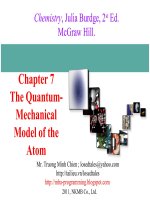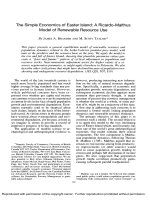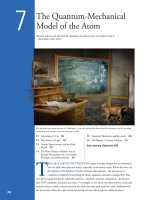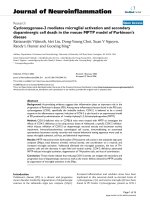The Hanoi Tower Model of Excellence
Bạn đang xem bản rút gọn của tài liệu. Xem và tải ngay bản đầy đủ của tài liệu tại đây (258.12 KB, 4 trang )
Personality traits and Environmental conditions
(Moderators)
Performance areas (Criteria)
Talent factors
(Predictors)
THE HANOI TOWER MODEL OF EXCELLENCE
Nga Giap Binh
PhD student of the faculty and Psychology of Excellence student
Psychometric approach:
Regardless of whether one is considering a psychometric conception of excellence in
terms of disposition for extraordinary achievements (in specific areas), one finds that all
most new theories tend to favor multi-dimensional models of high ability. Along the same
line, the Hanoi Tower Model of Excellence will be based on a psychometric classification
approach with several types of talent factors. This multidimensional model called “HTME”
(see Figure 1) consists of variety relatively independent ability factor groups (predictors),
and various performance domains (criterion variables), as well as personality traits and
social environment factors that serve as moderators for the transition of individual potentials
into excellent performance in various domains. This model is being implemented in Vietnam.
Environmental conditions (moderators)
− School
+ quality of instruction
+educational style
+ school climate, classroom climate
+ differentiated learning and instruction
− Family
+ home environmental stimulation
+ parental educational level
+ demands on performance made at home
+ number of siblings and sibling position
+ family climate
− Peers
+ critical life events
+ social reactions to success and failure
Legend:
Talent factors (predictors)
− Mind (language, mathematical, musical, spatial,
spiritual, interpersonal, intrapersonal, etc). Each of
them will be divided to assess.
− Creativity (language, mathematical, technical,
artistic, etc.)
− Social competence
− Practical ability
− Intellectual ability
Personality characteristics (moderators)
− Big five: Openness, Conscientiousness, Extroversion,
Agreeableness, Neuroticism (OCEAN)
+ achievement motivation
+ hope for success vs. fear of failure
+ control expectations
+ thirst for knowledge
+ ability to deal well with stress (coping with stress)
+ self-concept (general, scholastic, of talent, etc.)
− Creative problem solver: Fact Finding, Problem Finding, Idea
Finding, Solution Finding, Acceptance Finding
Performance areas (criteria variables)
− mathematics, computer science, etc.
− natural sciences
− technology, handicraft, trade, etc.
− languages
− arts, music (musical-artistic area)
− social activities, leadership, etc.
athletics/sports
EXCELLENCE
School
Family
Peers
Creative
Abilities
Intellectual
Abilities
Practical
Abilities
Social
Competencies
Logical-mathematic Mind
Spatial Mind
Spiritual Mind
Existential Mind
Body-Kinesthetic Mind
Musical Mind
Linguistic Mind
Naturalist Mind
Intrapersonal Mind
Interpersonal Mind
Lifelong Education: Formal and Informal
Lifelong Education: Formal and Informal
And So On
Technology
Computer
Science
Mathematics
And so on
Arts
Languages
Natural Sciences
Social Sciences
Military
Business Sports
Social
Relationships
E
A
C
O N
Big5
Fact Finding
Idea
Finding
Problem
Finding
Solution
Finding
Acceptance
Finding
Intellectual
powers
Intellectual
powers
Intellectual
powers
Intellectual
powers
Intellectual
powers
Intellectual
powers
Intellectual
powers
Intellectual
powers
Intellectual
powers
Intellectual
powers
Logical-
mathematic
thought
Spatial
thought
Spiritual
thought
Naturalist
thought
Existential
thought
Body-
Kinesthetic
thought
Musical
thought
Linguistic
thought
Intrapersonal
thought
Interpersonal
thought
Logical-
mathematic
memory
Spatial
memory
Spiritual
memory
Naturalist
memory
Existential
memory
Body-
Kinesthetic
memory
Musical
memory
Linguistic
memory
Intrapersonal
memory
Interpersonal
memory
Figure 1. The Hanoi Tower Model of Excellence (HTME)
Based on this model, one can have psychological profiles of some extraordinarily
intellectually gifted children, young people, as well as adults.
Assessing tools:
In order to assess the different dimensions of excellence, one must use a lot of tools, each
tool assesses a dimension. In this model, we will use LONGA software as an example
(written in Microsoft Visual Basic 2008 Express Edition by the author) to assess Creative
Thinking Abilities according to Torrance (1966) and more (see Figure 2). The LONGA
software is a useful tool, the data will be saved to SPSS to analyze it statistically. We
would like to suggest the following uses:
1. Basic studies that will yield a more complete understanding of the human mind
and its functioning and development.
2. Studies designed to discover effective bases for individualizing instruction.
3. Sources of clues for remedial and psycho-therapeutic programs.
4. Assessing the differential effects of various kinds of experimental programs, new
curricular arrangements or materials, organizational arrangements, teaching
procedures, and the like.
5. As a means of becoming aware of potentialities that might otherwise go
unnoticed.
Figure 2. The user interface of LONGA
References:
Gardner, H. (1983). Frames of mind: The theory of multiple intelligences. New York: Basic Books.
Sternberg, R. J., & Powell, J. S. (1982). Theories of intelligence. In R. J. Sternberg (Ed.), Handbook of
human intelligence (pp. 975-1005). New York: Cambridge University Press.
Torrance, E. P. (1974). The Torrance Tests of Creative Thinking-Norms-Technical
Manual Research Edition-Verbal Tests, Forms A and B- Figural Tests, Forms A and
B. Princeton, NJ: Personnel Press.









